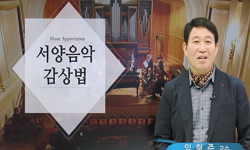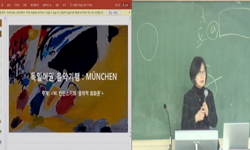Nationalism music, referring to the creation of a style of national sense in the work by the composer using the musical language or material unique to the nation to express the characteristics of an independent nation, began to gain attention with the...
http://chineseinput.net/에서 pinyin(병음)방식으로 중국어를 변환할 수 있습니다.
변환된 중국어를 복사하여 사용하시면 됩니다.
- 中文 을 입력하시려면 zhongwen을 입력하시고 space를누르시면됩니다.
- 北京 을 입력하시려면 beijing을 입력하시고 space를 누르시면 됩니다.
윤혜진의 새야 새야 파랑새야 주제에 의한 10개의 피아노 변주곡(2021) 분석연구 = A study on the analysis of Hyejin Yun's 10 variations on the theme of Saeya Saeya Parang Saeya for piano (2021)
한글로보기https://www.riss.kr/link?id=T16673689
- 저자
-
발행사항
전주 : 전주대학교 일반대학원, 2023
-
학위논문사항
학위논문(석사) -- 전주대학교 일반대학원 , 음악학과 , 2023.2
-
발행연도
2023
-
작성언어
한국어
- 주제어
-
KDC
679.311 판사항(5)
-
발행국(도시)
전북특별자치도
-
형태사항
v, 102 p. : 삽화, 악보, 표 ; 27 cm
-
일반주기명
지도교수: 김대욱
부록: 새야 새야 파랑새야 주제에 의한 변주곡 악보
참고문헌: p. 70-72 -
UCI식별코드
I804:45016-200000674064
- 소장기관
-
0
상세조회 -
0
다운로드
부가정보
다국어 초록 (Multilingual Abstract)
Through a formal analysis of variations, it was aimed to suggest how Korean To-ri, Jang-dan, and its folk songs melody were recreated by fusion with Western music. The overall form of the work consisted of ten variations. The melodies were varied by using the rhythms of the Yukjabaegi To-ri, a melody of Jeolla-do, and the Jungjungmori rhythm, which is mainly used in Namdo folk songs. In addition, rather than simply variations on the Western style of melody, harmony, rhythm, and structure, cadence that is not often used in tonal music such as deceptive cadence, picardy cadence, and amen cadence is used, and ambiguity of the tonality is applied, thereby reconstructing the melody of “Saeya Saeya Parang Saeya” into a modern style. In addition, the usage of the piano was maximized by using a wide range of sound, which is not often used in general piano music, and using dynamic, pedal-based ringing and continuous sound.
Conclusively with this work, it is expected that Korean unique musical usage be inherited and developed, and furthermore, it is hoped that more creative musical usages unique to Korea will emerge.
Nationalism music, referring to the creation of a style of national sense in the work by the composer using the musical language or material unique to the nation to express the characteristics of an independent nation, began to gain attention with the beginning of the nationalist movement in the 19th century. This study aimed to analyze the author's <10 Variations on the Theme of Saeya Saeya Parang Saeya for Piano (2021)>, which was composed by borrowing a Korean folk song melody, in accordance with this musical trend and thereby to develop a direction for the development of Korean contemporary music and to create its own musical language.
Through a formal analysis of variations, it was aimed to suggest how Korean To-ri, Jang-dan, and its folk songs melody were recreated by fusion with Western music. The overall form of the work consisted of ten variations. The melodies were varied by using the rhythms of the Yukjabaegi To-ri, a melody of Jeolla-do, and the Jungjungmori rhythm, which is mainly used in Namdo folk songs. In addition, rather than simply variations on the Western style of melody, harmony, rhythm, and structure, cadence that is not often used in tonal music such as deceptive cadence, picardy cadence, and amen cadence is used, and ambiguity of the tonality is applied, thereby reconstructing the melody of “Saeya Saeya Parang Saeya” into a modern style. In addition, the usage of the piano was maximized by using a wide range of sound, which is not often used in general piano music, and using dynamic, pedal-based ringing and continuous sound.
Conclusively with this work, it is expected that Korean unique musical usage be inherited and developed, and furthermore, it is hoped that more creative musical usages unique to Korea will emerge.
국문 초록 (Abstract)
변주곡이라는 형식 분석을 통해 한국의 토리와 장단이, 그리고 민요 선율이 서양 음악과 융합하여 어떻게 재창조되었는지 제시하고자한다. 작품의 전체 형식은 10개의 변주곡 형식으로 되어있다. 전라도 선율인 육자배기 토리와 남도민요에서 주로 사용되는 중중모리 장단을 리듬으로 활용하여 선율이 변주되었다. 이외에도 서양 양식인 선율, 화성, 리듬, 구조 등을 변주시켜 단순히 변주한 것이 아니라 허위종지, 피카르디종지, 아멘종지 등 조성음악에서 자주 사용되지 않은 종지를 사용하고, 조성의 모호함을 주어 “새야 새야 파랑새야”선율을 현대적인 느낌으로 재구성 하였다. 또한 일반적인 피아노곡에서는 잘 활용되지 않은 넓은 음역대 사용과 다이나믹, 페달을 사용한 울림, 지속음 사용으로 피아노의 활용을 극대화 하였다.
이를 통해 한국 고유 음악 어법이 계승·발전되기를 바라고 더 나아가 한국만의 창의적인 음악 어법이 더 많이 출현하기를 바라는 바이다.
국민주의 음악은 19세기 민족주의 운동이 시작하면서 주목받기 시작하였고, 작곡가가 독립적인 민족 특성을 나타내기 위해 민족 고유의 음악어법이나 제재를 사용함으로써 작품 속에 민족...
국민주의 음악은 19세기 민족주의 운동이 시작하면서 주목받기 시작하였고, 작곡가가 독립적인 민족 특성을 나타내기 위해 민족 고유의 음악어법이나 제재를 사용함으로써 작품 속에 민족적인 감각의 양식을 창조하는 것을 말한다. 이러한 음악 사조를 따라 한국 민요 선율을 차용하여 작곡한 본 연구자의 <“새야 새야 파랑새야” 주제에 의한 10개의 피아노 변주곡(2021)>을 분석하여, 한국 현대 음악 발전 방향성과 고유 어법 창안에 목적을 두고 있다.
변주곡이라는 형식 분석을 통해 한국의 토리와 장단이, 그리고 민요 선율이 서양 음악과 융합하여 어떻게 재창조되었는지 제시하고자한다. 작품의 전체 형식은 10개의 변주곡 형식으로 되어있다. 전라도 선율인 육자배기 토리와 남도민요에서 주로 사용되는 중중모리 장단을 리듬으로 활용하여 선율이 변주되었다. 이외에도 서양 양식인 선율, 화성, 리듬, 구조 등을 변주시켜 단순히 변주한 것이 아니라 허위종지, 피카르디종지, 아멘종지 등 조성음악에서 자주 사용되지 않은 종지를 사용하고, 조성의 모호함을 주어 “새야 새야 파랑새야”선율을 현대적인 느낌으로 재구성 하였다. 또한 일반적인 피아노곡에서는 잘 활용되지 않은 넓은 음역대 사용과 다이나믹, 페달을 사용한 울림, 지속음 사용으로 피아노의 활용을 극대화 하였다.
이를 통해 한국 고유 음악 어법이 계승·발전되기를 바라고 더 나아가 한국만의 창의적인 음악 어법이 더 많이 출현하기를 바라는 바이다.
목차 (Table of Contents)
- Ⅰ.서론 1
- 1. 연구의 목적 및 필요성 1
- 2. 연구의 범위 및 방법 3
- Ⅱ. 본론 5
- 1. 이론적 배경 5
- Ⅰ.서론 1
- 1. 연구의 목적 및 필요성 1
- 2. 연구의 범위 및 방법 3
- Ⅱ. 본론 5
- 1. 이론적 배경 5
- 1) 국민주의(Nationalism in Music) 5
- 2) 한국 민요의 특징 8
- (1) 통속민요와 토속민요 8
- (2) 지역별 토리 9
- 3)“새야 새야 파랑새야”역사적 배경 14
- (1) 동학농민혁명의 정의와 의미 14
- (2) 지역별로 다르게 구전된 “새야 새야 파랑새야” 14
- 4) 음악 형식 19
- (1) 변주곡(Variation)의 설명 19
- (2) 변주기법 21
- 2. <새야 새야 파랑새야 주제에 의한 10개의 피아노 변주곡(2021)>의 작품 분석 27
- 1) 작품 개요 27
- 2) 작품 분석 30
- Ⅲ. 결론 68
- 참고문헌 70
- 부록 73
- 국문초록 99
- ABSTRACT 101












